Вы здесь
National kitchen of Kazakhs.
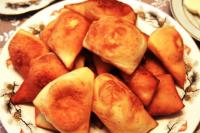
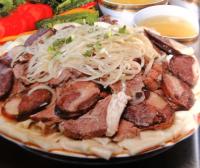
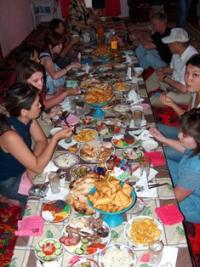
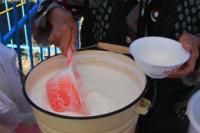
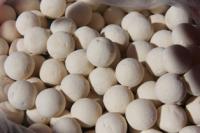
National kitchen of Kazakh people.
One of the most features of the Kazakh peoples since ancient times has been hospitality. A guest would be cordially welcomed, seated at the most respected place and given the best from what was in the house.
Meat is the basis for the most dishes. Delicatessen meat products such as kazy, shuzhyk, zhak, zhaya and karta are made of horse meat. The traditional Kazakh cuisine prefers boiling. Milk and sour milk products have been used broadly since long ago. Kumis, shubat and airan were easier to keep in nomadic environment. Bread was baked in the form of flat cake. The most favorite dough product is baursak and the most popular drink is white tea.
Any repast in a Kazakh family begins with milk beverages such as kumis, shubat or airan. The next served are white tea, baursaks, raisins, irinshik and kurt. These are followed by cold horse meat food such as kazy, shuzhyk, zhal, zhaya and karta.
The only hot snack food in the Kazakh cuisine is kuurdak. However, the most favorite food was and is beshbarmak or Kazakh meat. A repast is ended with kumis followed by tea again. A decoration for any dastarkhan and the most favorite food among Kazakhs has always been the Kazakh meat.
A boiled meat used to be served in big undressed lumps. The host would cut the meat giving tasty morsels to each guest: hip bones and shins to respected old men; breast to a son or daughter-in-law; neck bone to girls, etc. The most respected guest would be given a specially cooked sheep’s head.
The guest would divide the head among those present according to a certain ritual reflecting an ancient custom of respectful attitude to guests, old people, children, and close and far relatives.
Aromatic meat shall be eaten with thin rolled out and boiled dough panes. A good addition to the dish is a saturated aromatic meat broth – sorpa – usually served in pialas. A meal shall be ended with kumis and again followed by tea.
Nowadays, meal has changed its form in many aspects but did not lost ancient hospitality laws. On the contrary, it extended its limits: today’s dastarkhan gathers not only ethnic Kazakhs but also numerous guests who live in our multi-ethnic Republic such as ethnic Russians, Tatars, Ukrainians, Uzbeks, Germans, Uigurs, Dungans or Koreans.
The modern Kazakh cuisine includes not only the traditional Kazakh food but also favorite Uzbek, Uigur, Russian, Tatar, Korean and other dishes. That is why one can easily see little international traits in the modern Kazakh cuisine though it keeps purely ethnic features.
The Kazakh people has accumulated a huge experience in processing and making meat and sour milk products for many centuries of its history while the modern times added vegetables, fruits, fish, sea products, cookies, flour products and sweets to this range.
However, the most popular product in the Kazakh cuisine has always been meat. Meat is the basis for the most dishes. It is the meat products that embellish any dastarkhan. The perception of whether a holiday table is rich and diverse is based on the abundance of meat dishes.
Since old times, the Kazakh cookery has been characterized with its peculiar technology. The Kazakh life style told on cooking methods. The traditional Kazakh cuisine has always preferred boiling. This process allows having mild and tender taste tints of meat and adds succulence and aroma.
Much importance was given to the procurement and long storage of products. During slaughtering, a part of meat was put by to be salted, dried and sometimes smoked. Delicatessen products were mostly cooked from horse meat such as kazy, zhuzhyk, zhal, zhaya, karta, etc.
From grain crops, the Kazakh cookery prefers wheat and millet. A peculiar technology of making dairy and groats dishes provides a unique taste and original assortment that cannot be found in other cuisines.
Bread was mainly baked in the flat form. The most popular baked product has been baursaks. Flour products are very important for the Kazakh cuisine. Kazakh ethnic flour products and sweets are made of premium or grade a flour adding milk, yeast, sour cream, eggs, fat, nuts, honey, sugar, water and salt. It is very important to observe the cooking technology, products dosing, temperature and time.
The most favorite beverages have always been kumis, shubat and airan. Tea has always been special. The Kazakh cuisine traditions and specificities have a long history. In ancient times, this land was the northern section of the Silk Road where caravans went from Turfan to Sogd.
Modern Kazakhstan was the part of the Turkic Kaganat that included cattle-breeding nomad tribes. The nomad cookery traditions and rites had an indelible mark on the Kazakh ethnic cuisine.
The host will meet and set the guest to the table in a modern house or shepherd’s yurt. First of all, the guest will be offered tea served in a Kazakh house only by girls or young women. The guest who quenched his thirst will be given the syi ayak – a teacup of honor. The tea will be served with flat bread, milk cream – kaimak – and butter, dry fruits, nuts and sweets.
Traditionally, the Kazakh cuisine has many meat dishes. One of the most popular is kuurdak – hot roast lamb liver, kidneys, heart, lungs and tail fat. Smoked, dried, boiled lamb and horse meat is usually eaten with milk tonics. Katyk from sour cow milk tastes like yoghurt and is freshening while exotic drinks such as shubat from camel milk or kumis can provide a weak drunkenness. The world-famous kumis is made from fresh mare’s milk made sour in big leather wineskins.
The fermentation time is three to five days depending on the fat content and thickness of milk. The low alcohol content of 1.5 to 3 percent is provided by the aconite’s root added to the ferment. Kumis contains biologically active substances, is famous for its healing power and increases immunity.
The main traditional Kazakh food – besbarmak – boiled horse meat or lamb with broth-boiled cut little dough pieces and abundantly sprinkled with dill, parsley and coriander, is served on a large oval dish. Besbarmak is served according to a specific ritual.
The most respected guest will be given koi bas – a boiled sheep head. He will dress it and divide among other guests. Each part of the head has its own meaning. Boys are given the ears as they are whished to be attentive. Girls get the palate to be hard-working.
The most respected guests will also be served with sheep hams and shin. The breast will be given to the young daughter-in-law and the neck-bone to married women. Boys will have the kidneys and heart to grow into a man faster. The sheep’s brain is prohibited for children otherwise they will be weak-willed. A young girl is never given an ulnar bone which will prevent her from being too long unmarried.
Besbarmak will be served with special flat breads and cups filled with sorpa broth. Having tasted Kazakh ethnic dishes once, you will feel the aromatic breath of a steppe wind and the romantics of the nomad life. The modern ethnic cuisine includes not only the traditional Kazakh food but also the food of many other ethnic groups living in South Kazakhstan. Today, you can often meet together with meat and sour milk products the bird, fish, vegetable dishes and an abundance of flour products and sweets.
The Kazakh cuisine will not leave anybody indifferent! Some Central Asian dishes are only cooked in the tandyr – a special clay oven. A real samsa – little meat patty – is said to only be baked in a tandyr. In addition, traditional flat bread is also baked in tandyr.
Taste old ethnic recipes, enjoy the Oriental abundance of dastarkhan, get familiar with the southern hospitality and feel the spirit of Central Asia – in South Kazakhstan!
Authority:
www.kazakhstan-tourist.isd.kz Kitchen of Kazakhs. Almatykitap. 2006
Photo
Alexander Petrov.







